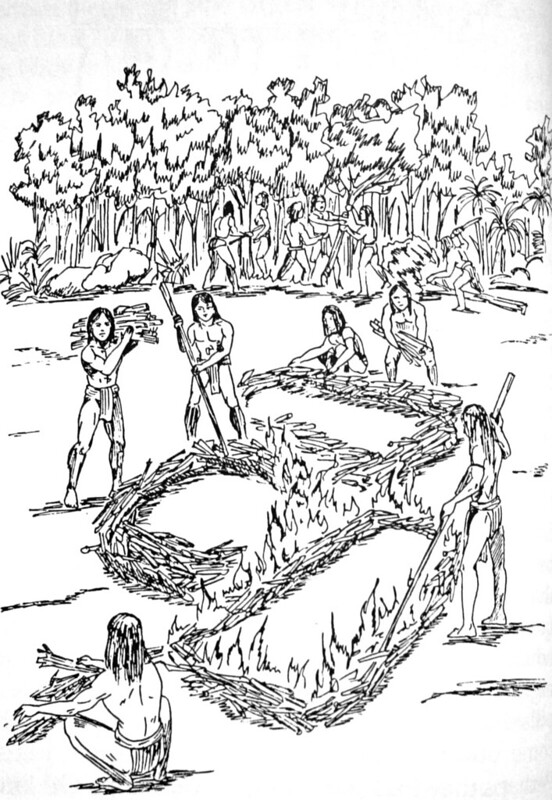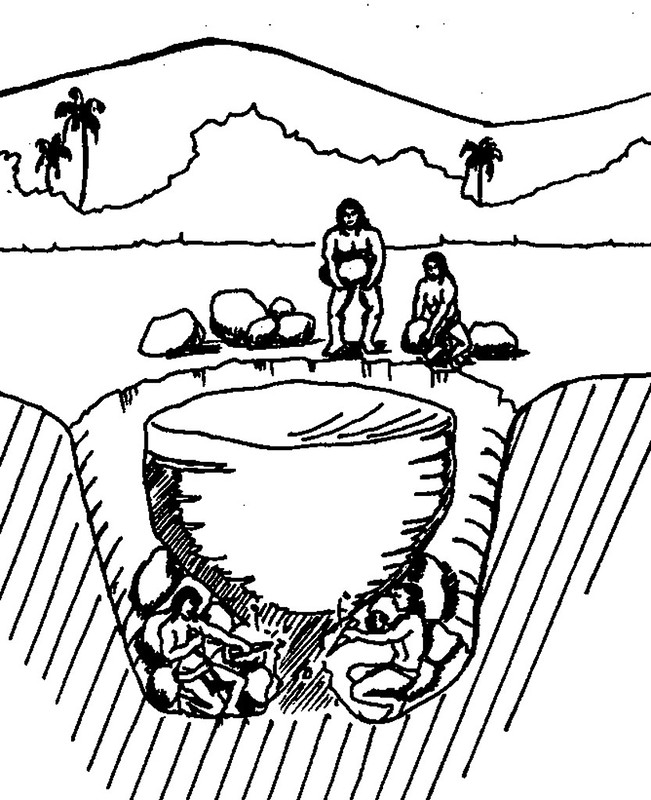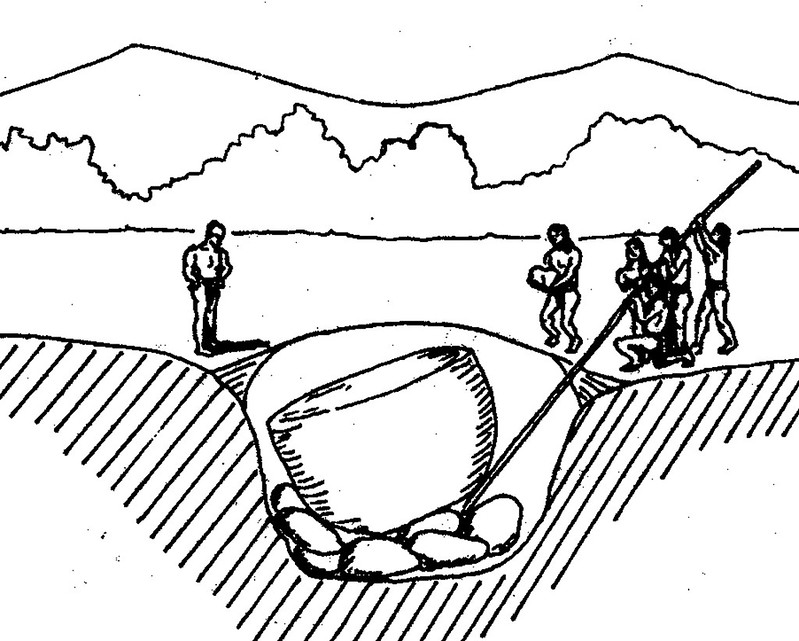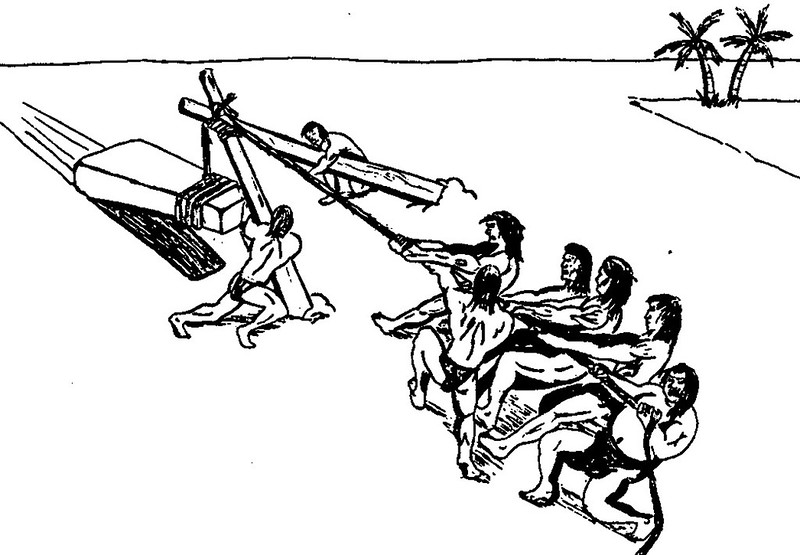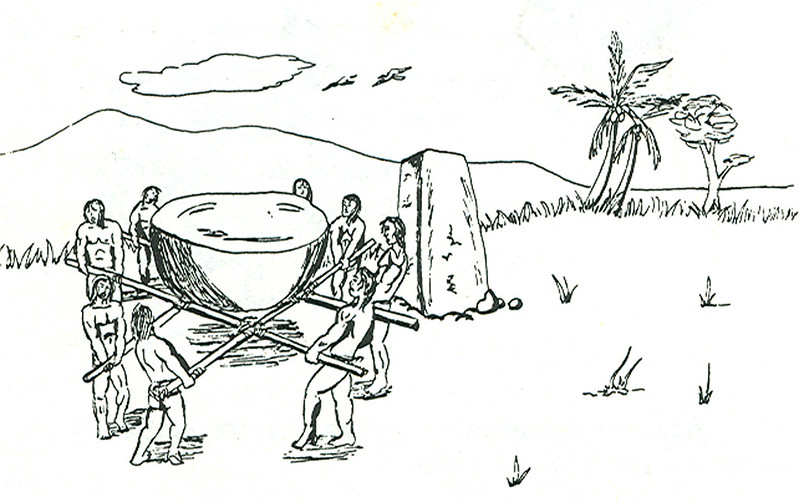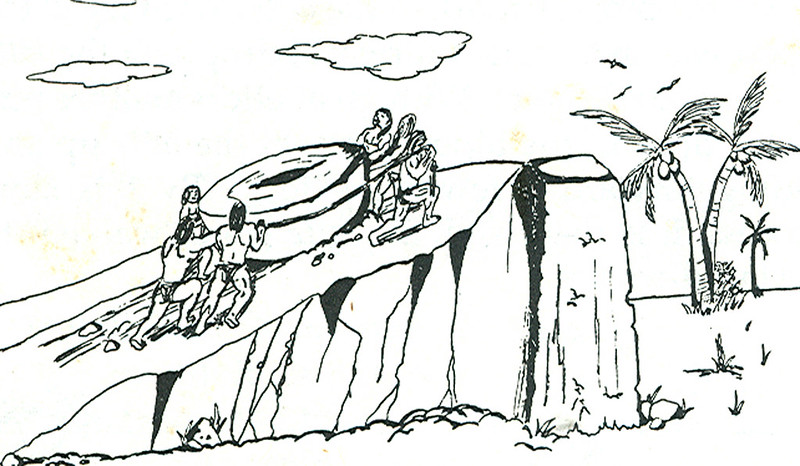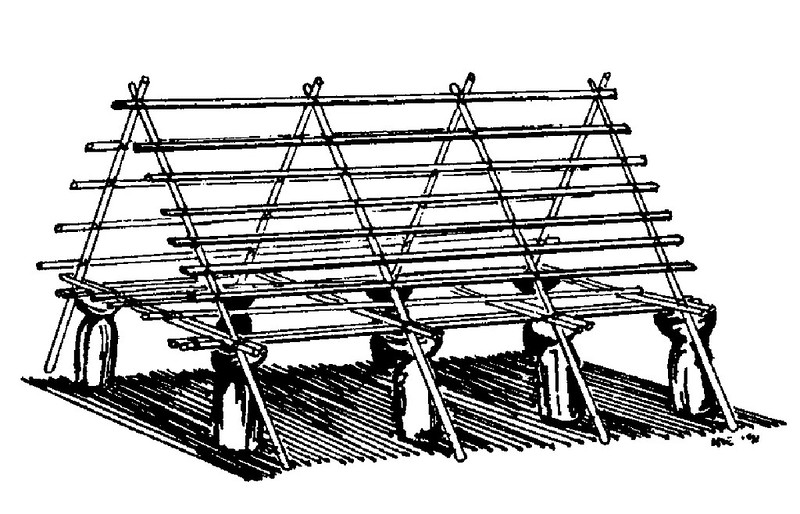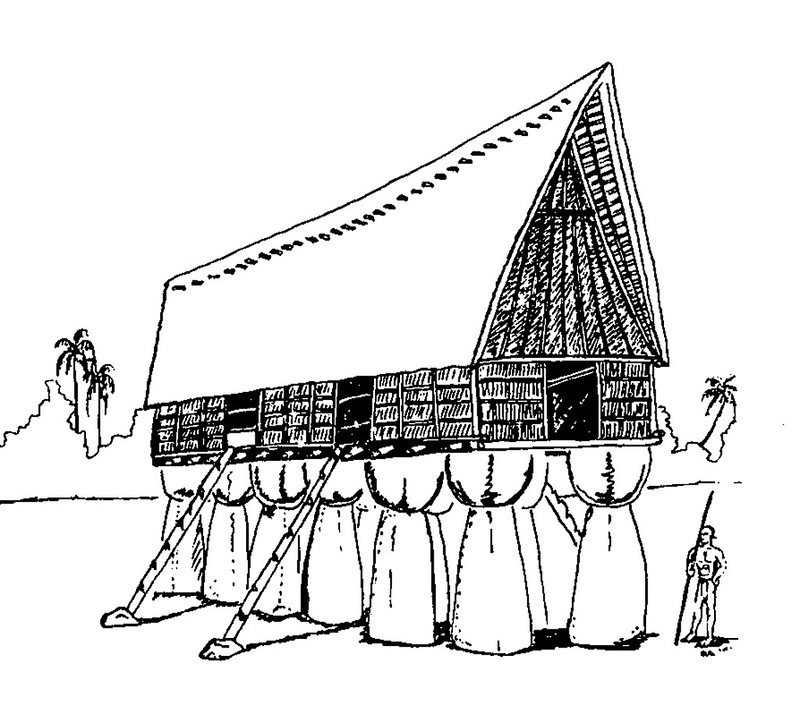Houses of the Ancients
Latte structures are stone archaeological remains unique to the Mariana Islands. A stone pillar supports a hemispherical capstone to form a latte. The ancient CHamorus generally arranged latte in two parallel rows of four or more pairs to support their important rectangular, steep pitched roof, pole and thatch buildings. Communities in coastal areas, river valleys, and a few upland areas, seem to have competed to build larger and larger latte structures. The Spanish missionaries referred to the latte as casa de los antigos or houses of the ancients. Latte have become a significant icon in contemporary Mariana Islands architecture and serve as a symbol of the CHamoru people and their proud past.
Ancient CHamorus used latte as a foundation for wooden with thatch roof structures. Several archaeologists disagree on the date of the earliest latte. Some say that CHamorus built latte as early as 1200 BP, others think it was not until 800 BP, but these experts generally agree that CHamorus stopped building traditional latte houses by 300 BP.
CHamorus inhabited Guam and the Mariana Islands at least 2,800 years before they constructed latte. Many experts regard latte and the cultural complex of tools and pottery associated with them as a natural development of CHamoru culture. Nevertheless, some are convinced that latte were the work of a conquering people who invaded the Marianas or perhaps another wave of migration.
Latte architecture
Latte look rather like a huge mushroom with its top inverted. Latte is composed of a hemispherical stone cap setting on a rectangular or trapezoidal stone pillar. The cap is a tasa or cup. The pillar is an haligi. Usually latte are four or five pairs of stones, but there are also three, six and, occasionally, a set has two rows of seven pairs. Some of the houses are approximately twelve feet wide and forty-eight feet long. In a few cases, there were wings off to the side of the main axis. Viewed from above these latte structures took on the shape of a cross. In Guam the latte range from a couple of feet high to almost seven feet. Most frequently they are from four to six feet high.
The latte structures are found extensively throughout the main islands of the Marianas archipelago: Guam, Rota, Tinian, and Saipan. Some of the smaller islands in the Northern Marianas also contain latte. The largest standing latte is the House of Taga in Tinian, where capstones measure between 2.7 – 2.48 meters in diameter and shafts are 3.87 – 4.23 meters long. The CHamorus never completed what would have been the largest latte in the Marianas. Those latte elements remain in the quarry at the As Nieves in Rota. The northernmost latte sets or structures are located on the island of Pagan.
In Guam, Fred M. Reinman, PhD was the first to complete extensive archeological documentation on the latte in 1965 and 1966. Reinman and his team identified nearly 140 archaeological sites many of which had multiple latte sets. One typical coastal site originally had eight structures with ten pillars and their caps. Although there are many exceptions, CHamorus often placed the long axis of the latte sets parallel to a natural physical feature like the sea, a cliff, or a river. In northern Guam latte sets are frequently perpendicular to the cliff. A desire to take advantage of the East-Northeast trade winds, and perhaps some other phenomena associated with traditional beliefs, may explain this anomaly.
Ancient CHamorus constructed wooden and thatched roof A-frame houses on top of the stone pillars and capstones. These houses are generally thought to be for the high ranking or high caste families in the village. This caste comprised of the matao or matua class and the lower ranking acho’at class. However, the largest latte in Guam are in the interior, which is reported to be where many of the low caste, or manachang, lived.
Some latte structures served as guma’ uritao, or men’s house. This was a meeting place for men and a living quarters for bachelors. Latte structures also sheltered ocean going outrigger sailing canoes called proas and may have served as a place to build the proas. One such cross-shaped shelter in Humåtak is reported to have been large enough for canoes and sixty people in each of the four wings. Some researchers believe that latte without structures on them may have indicated a claim to the land. Latte sets may have also been used as platforms to store food.
Why did the CHamorus choose to build their houses on such substantial two-part stone pillars? Archeologists have suggested several possibilities: Stone does not rot, nor could it be eaten by termites or boring beetles. A raised floor has several advantages: it’s dryer, it allows air to circulate under the house, and in the taller latte structures, it provides a sheltered work space under the house, and a tactical advantage in case of an attack. The two-part latte – pillar and cap, may have acted as a shock absorber and protected the building during an earthquake. The cap extending up and outward from the pillar may have reduced the number of crabs and vermin paying an unwelcome visit to the inhabitants and/or food storage areas.
None of these hypotheses explain why some of the latte were so large. In the hierarchical CHamoru society, perhaps inter- and intra-village competitiveness lead to larger and larger latte structures. A large latte structure would be visual evidence of the success of an extended family or village. A huge latte structure could have been viewed as tangible evidence the cooperative or harmonious (inafa’maolek) spirit within a social group. It could have been a statement of strength and a warning to potential enemies.
Building latte
Many archaeologists no longer support the theory that the CHamorus used fire in the quarrying of latte. In the earliest stages of latte building, CHamorus found rocks that needed little shaping for the pillar. They frequently used beach rock slabs for the shaft. The cap was an inverted brain coral head taken from the reef as well as limestone and basalt that required only minimal shaping. As they needed larger and larger rocks, they quarried them from the sides of limestone outcroppings or cleared the vegetation and soil in an effort to find an area of faultless or desired type of limestone.
Next they laid out rectangular or trapezoid shapes for the haligi and circles for the tasa. Then with basalt tools they began to chip the stone. As the quarrymen chipped the stone with basalt adzes and axes, they removed the rubble by hand or wooden shovels. Successive poundings and scrapings formed a trench around the outlines of the latte elements. After the quarrymen dug to the desired depth, they began undercutting the stone from all sides. After many hours of hard work, they were left with only a narrow “keel” supporting the latte element.
As they chipped away at the “keel” they had to shore up the latte, with rocks, so it would not fall on the quarrymen when they chipped the last of the “keel” away. At this stage, the shaft or cap rested in its pit on supporting rocks and was ready to be removed. Next, many workers pushed down on wooden pole levers placed under the latte element raising it a few inches at a time. In the space under the latte element quarry men placed more supporting rubble. They repeated this over and over again going around the latte element lifting it, and filling in under the shaft or cap. At last the latte element rested above its former pit which was completely filled with backfill materials; rock rubble. The CHamorus probably used chisels and adzes to complete the final sculpting of the latte parts at the building site.
There are several theories about how the CHamorus were able to transport the latte. It is possible that many of the latte shafts and caps in Guam were either dragged with ropes or placed on litters and carried to the building site. For the larger shafts and caps, they probably used a bipod lever made by lashing the top ends of two good size wooden poles together. They position the bipod lever with the legs pointing away from the latte and the apex close to the shaft or cap. They attached a short rope to the apex of the bipod lever and tied the other end to the latte cap or shaft.
Next many workers pulled away from the latte on a long rope from the apex of the bipod lever. This force lifted the end of the shaft or cap off the ground and pulled the stone toward the pullers. After each pull they had to reset the bipod lever and repeat the process over and over again until they reached the building site. They probably put coconut frond skids under the shaft or cap to make it easier to slide along the ground. It is thought by this process, the CHamorus moved the heaviest of the latte caps and shafts to the building site.
In Guam, strong workers lifted most latte shafts in place using physical force, ropes, and perhaps with a pole frame to put the caps in place. CHamorus placed the largest end of the haligi in a hole dug to the desired depth and supported it by placing rocks on all sides. Finally they filled the hole with backfill materials. CHamorus probably scooted and pulled the largest tasa up an earthen ramp to finally rest on the top of the haligi. Once the cap was in place, they removed the earthen ramp.
After parallel rows of three to seven pairs of pillars and caps were in place, the workers lashed timbers in place probably with coconut fiber rope to form an A-frame structure, which was thatched with woven or sewn palm leaves, pandanus, or perhaps swordgrass. The buildings are reported to have had several rooms separated with woven mats and to have had walls and windows.
Many latte sites were destroyed or abandoned following the Spanish colonization of the Mariana Islands beginning in 1668. Foreign diseases and warfare decimated Guam and the rest of the Marianas population. Through a process called reducción the Spanish authorities moved the CHamorus to organized communities with churches, converted them to Christianity, and taught them a European way of life. The Spanish moved the population to just six villages. They built their houses on wooden posts instead of stone. In the abandoned villages all that has survived to modern times are the latte, the ancestral remains buried under and to the sides of the latte, some pottery, stone, bone, and shell, artifacts, and the strong memory of the ancestral spirits.
Icon
The latte is now a significant icon for Guam and the CHamoru people. Modern architecture such as the AB Won Pat Guam International Airport Authority, school bus stop shelters, entrances to most of Guam’s villages, the Archbishop’s residence, the governor’s residence, the University of Guam, Naval Station, the CHamoru Village, the Ricardo J. Bordallo Governor’s Complex, and the Guam Legislature, just to name a few, make use of the latte motif.
Today with the help of a guidebook and the permission of the land owner, you can visit jungles with latte sites. Or you can visit the more accessible Senator Angel Leon Guerrero Santos Latte Memorial Park or the latte in front of the Robert F. Kennedy Memorial Library at the University of Guam. These latte were moved to their respective sites from the Fena River valley. Latte sites are protected by local and federal law. When visiting a latte site always show respect for the dead and for Guam’s proud past.
By Lawrence J. Cunningham, EdD
For further reading
April, Victoriano N. Latte Quarries of the Mariana Islands. Hagåtña: Guam Department of Parks and Recreation Historic Resources Division, 2004.
Carson, Mike T., ed. “Archaeological Studies of the Latte Period.” Micronesica 42, no. 1/2 (2012): 1-79.
Cunningham, Lawrence J. Ancient Chamorro Society. Honolulu: Bess Press, 1992.
Reinman, Fred. An Archaeological Survey and Preliminary Test Excavations on the Island of Guam, Mariana Islands, 1965-1966. Mangilao: Micronesian Area Research Center, University of Guam, 1977.
Thompson, Laura M. Archaeology of the Mariana Islands. 1932. Reprint, New York: Krause Reprint Co., 1971.

